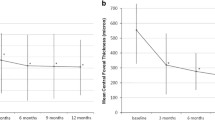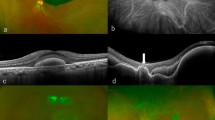Abstract
Purpose
To investigate the risk factors for subconjunctival hemorrhage (SCH) after intravitreal injection of anti-vascular endothelial growth factor (anti-VEGF) and evaluate the relationship between hemodynamic status at the time of injection and SCH.
Methods
We retrospectively reviewed the medical records of 598 cases of 173 patients who underwent intravitreal injection of ranibizumab whose hemodynamic status was monitored at the time of the injection. Cases with SCH after the injection were included in the SCH group. We compared systemic factors, including the hemodynamic status between the SCH group and the control group.
Results
The SCH group included 67 cases and the control group included 531 cases without SCH. Baseline hemodynamic status was not significantly related to development of SCH. However, systolic blood pressure (BP) at injection was a significant risk factors for SCH (P = 0.034). Elevated systolic BP, mean arterial pressure (MAP), and pulse rate from baseline to time of injection were significantly related to the development of SCH (P = 0.011, P = 0.014, P = 0.036, respectively). In multivariate analysis, hypertension, a large change in MAP, and a fewer previous injections were significant risk factors for SCH after intravitreal injection (P = 0.030, P = 0.032, P = 0.028, respectively).
Conclusions
Hemodynamic risk factors exist for SCH after intravitreal injection of anti-VEGF. To reduce the risk of SCH, strategies should seek to decrease patient anxiety, especially in those with hypertension.

Similar content being viewed by others
References
Doshi RR, Bakri SJ, Fung AE (2011) Intravitreal injection technique. Semin Ophthalmol 26:104–113
van der Reis MI, La Heij EC, De Jong-Hesse Y, Ringens PJ, Hendrikse F, Schouten JS (2011) A systematic review of the adverse events of intravitreal anti-vascular endothelial growth factor injections. Retina 31:1449–1469
Jager RD, Aiello LP, Patel SC, Cunningham ET Jr (2004) Risks of intravitreous injection: a comprehensive review. Retina 24:676–698
Fukuyama J, Hayasaka S, Yamada K, Setogawa T (1990) Causes of subconjunctival hemorrhage. Ophthalmologica 200:63–67
Pitts JF, Jardine AG, Murray SB, Barker NH (1992) Spontaneous subconjunctival haemorrhage—a sign of hypertension? Br J Ophthalmol 76:297–299
Wilson RJ (1986) Subconjunctival hemorrhage: overview and management. J Am Optom Assoc 57:376–380
Mimura T, Usui T, Yamagami S, Funatsu H, Noma H, Honda N, Amano S (2010) Recent causes of subconjunctival hemorrhage. Ophthalmologica 224:133–137
Pan W (2001) Akaike’s information criterion in generalized estimating equations. Biometrics 57:120–125
Bhargava M, Ikram MK, Wong TY (2012) How does hypertension affect your eyes? J Hum Hypertens 26:71–83
Wong TY, Mitchell P (2007) The eye in hypertension. Lancet 369:425–435
Dayani PN, Siddiqi OK, Holekamp NM (2007) Safety of intravitreal injections in patients receiving warfarin anticoagulation. Am J Ophthalmol 144:451–453
Mason JO 3rd, Frederick PA, Neimkin MG, White MF Jr, Feist RM, Thomley ML, Albert MA Jr (2010) Incidence of hemorrhagic complications after intravitreal bevacizumab (Avastin) or ranibizumab (Lucentis) injections on systemically anticoagulated patients. Retina 30:1386–1389
Horn W, Hoerauf H (2008) Intravitreal injections during anticoagulant treatment. Klin Monatsbl Augenheilkd 225:217–219
Manzoni GM, Pagnini F, Castelnuovo G, Molinari E (2008) Relaxation training for anxiety: a ten-year systematic review with meta-analysis. BMC Psychiatry 8(2):41
Jacob RG, Kraemer HC, Agras WS (1977) Relaxation therapy in the treatment of hypertension. a review. Arch Gen Psychiatry 34:1417–1427
Financial support
This study was supported by a grant from the Korea University (K1400675).
Conflict of Interest
The authors do not have any conflicts of interest to declare.
Author information
Authors and Affiliations
Corresponding author
Rights and permissions
About this article
Cite this article
Yun, C., Oh, J., Hwang, SY. et al. Subconjunctival hemorrhage after intravitreal injection of anti-vascular endothelial growth factor. Graefes Arch Clin Exp Ophthalmol 253, 1465–1470 (2015). https://doi.org/10.1007/s00417-014-2837-6
Received:
Revised:
Accepted:
Published:
Issue Date:
DOI: https://doi.org/10.1007/s00417-014-2837-6




